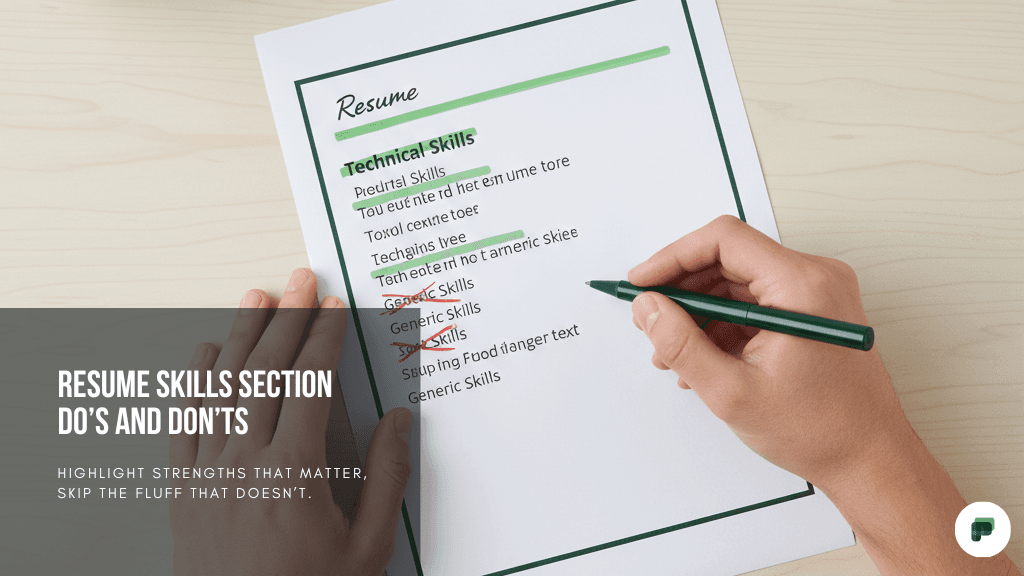How to Measure the Effectiveness of Your Resume: A Data-Driven Approach to Career Success


Pranav Lakherwal
How to Measure the Effectiveness of Your Resume: A Data-Driven Approach to Career Success
TL;DR
- Transform Your Job Search Strategy: Move beyond submitting resumes blindly. Implement systematic tracking of key performance metrics like application-to-response ratios, interview conversion rates, and time-to-response to understand what drives results and what needs improvement.
- Master ATS Optimization for Maximum Visibility: With 75% of resumes filtered out by Applicant Tracking Systems before human review, technical optimization is non-negotiable. Leverage advanced resume optimization tools like Prepzo.ai's analyzer to ensure keyword alignment, formatting compliance, and ATS compatibility.
- Embrace Continuous Improvement Through Testing: Treat your resume as a dynamic marketing asset. Employ A/B testing methodologies, analyze performance data, and iterate based on real-world feedback to achieve significantly higher response rates and interview opportunities.
- Leverage AI-Powered Insights for Competitive Advantage: Utilize sophisticated resume scoring and analysis platforms to gain objective, data-driven feedback on content impact, technical compliance, and optimization opportunities that accelerate your path to career success.
In today's hyper-competitive professional landscape, your resume serves as far more than a simple career summary—it's your primary marketing instrument, a strategic asset that determines your visibility in the job market and directly influences your career trajectory. Yet despite its critical importance, the vast majority of professionals approach resume management with surprising casualness, submitting documents without systematic performance tracking or strategic optimization.
This fundamental disconnect between the resume's importance and how it's managed represents one of the most significant missed opportunities in professional development. At Prepzo.ai, we champion a revolutionary approach: treating your resume as a measurable, optimizable marketing campaign that demands the same analytical rigor you'd apply to any other critical business initiative.
This comprehensive guide will transform your understanding of resume effectiveness, providing you with the frameworks, tools, and strategies to measure, analyze, and dramatically improve your resume's performance. You'll learn to shift from hope-based job searching to data-driven career advancement, ultimately achieving measurably better results in your professional pursuits.
The Strategic Imperative: Why Resume Measurement Is Career-Critical
The modern hiring ecosystem operates on unprecedented scale and complexity. Recruiters process hundreds of applications per role, while sophisticated Applicant Tracking Systems (ATS) serve as automated gatekeepers, filtering candidates before human review. In this environment, operating without performance measurement is not just inefficient—it's professionally negligent.
The Compelling Case for Data-Driven Resume Management
Quantifiable Return on Investment: Every hour spent job searching represents an investment of your most valuable resource: time. Without measurement, you cannot optimize this investment or identify which activities generate the highest returns. Professionals who implement systematic tracking report up to 40% higher response rates compared to those using static approaches.
Precision Problem Identification: Is your resume failing at the ATS level, or are you reaching human reviewers but failing to convert to interviews? Measurement provides surgical precision in identifying exactly where your resume's performance breaks down, enabling targeted improvements rather than generic optimizations.
Strategic Resource Allocation: When you understand which resume versions, application strategies, or job types yield superior results, you can concentrate your efforts on high-impact activities while eliminating time-wasting approaches.
Accelerated Professional Learning: Each application becomes a valuable data point in your professional development. Systematic tracking transforms every job search interaction into actionable intelligence about market demands, employer preferences, and your competitive positioning.
Confidence and Momentum Building: Witnessing measurable improvements in your resume's performance creates positive psychological momentum, transforming job searching from a discouraging process into an empowering journey of continuous improvement.
The Stark Reality of Resume Performance
Industry research reveals sobering statistics about resume effectiveness: only 2-3% of submitted resumes typically result in interviews. This means that for every 100 applications, 97-98 yield no positive response. However, professionals who employ rigorous measurement and optimization strategies consistently achieve response rates of 8-12% or higher—a 300-400% improvement over baseline performance.
These dramatic improvements aren't accidental; they result from systematic application of measurement principles, strategic optimization, and continuous refinement based on real-world performance data.
Quantitative Metrics: The Foundation of Resume Analytics
Effective resume measurement begins with establishing clear, quantifiable metrics that provide objective insights into your document's performance throughout the hiring funnel. These metrics serve as your professional dashboard, revealing trends, identifying opportunities, and tracking improvement over time.
Primary Performance Indicators
1. Application-to-Response Ratio: Your Core Effectiveness Metric
This fundamental metric measures the percentage of applications that generate any form of positive employer engagement, serving as your primary indicator of resume effectiveness and market appeal.
Calculation Formula: (Number of Positive Responses ÷ Total Applications Submitted) × 100
Performance Interpretation: This ratio directly reflects your resume's ability to capture attention and demonstrate relevance. Low ratios typically indicate ATS compatibility issues, keyword misalignment, or fundamental content problems that prevent your resume from reaching human reviewers.
Industry Benchmarks: While baseline response rates hover around 2-3%, exceptional performers achieve 8-15% through strategic optimization. Your goal should focus on continuous improvement relative to your personal baseline rather than chasing arbitrary industry averages.
Optimization Insights: Declining ratios often signal market changes, increased competition, or the need for resume refreshing. Improving ratios indicate successful optimization and better market alignment.
2. Interview Conversion Rate: Quality Assessment Beyond Initial Interest
This metric evaluates how effectively your resume converts initial employer interest into concrete interview opportunities, providing insights into content quality and positioning effectiveness.
Calculation Formula: (Number of Interview Invitations ÷ Number of Positive Responses) × 100
Strategic Significance: High response rates with low interview conversion suggest that while your resume generates initial interest, the content fails to compel deeper engagement. This typically indicates insufficient achievement quantification, weak value proposition articulation, or misalignment between your positioning and employer expectations.
Optimization Applications: Low conversion rates point to content quality issues rather than technical problems, directing your improvement efforts toward achievement enhancement, storytelling refinement, and value proposition strengthening.
3. Time-to-Response Analysis: Market Demand Intelligence
Tracking response timing provides valuable intelligence about market demand for your skills, employer urgency, and your competitive positioning within specific sectors or roles.
Measurement Approach: Record the number of business days between application submission and first positive response for each application.
Market Intelligence Value: Rapid responses (1-3 days) often indicate high demand for your skill set, urgent hiring needs, or strong profile alignment. Extended response times may suggest lower priority hiring, competitive candidate pools, or less optimal profile matching.
Strategic Applications: Use timing patterns to identify high-demand skill areas, optimize application timing, and prioritize follow-up efforts on faster-responding opportunities.
4. Advanced Metrics for Comprehensive Analysis
Offer-to-Interview Ratio: Measures your overall candidacy strength by tracking how many interviews convert to job offers. While influenced by factors beyond resume quality, this metric provides insights into how well your resume positions you for interview success.
Industry-Specific Performance Tracking: Segment your metrics by industry, company size, or role type to identify where your resume performs most effectively, enabling more targeted job search strategies.
Geographic Performance Analysis: Track response rates by location to identify regional preferences, market conditions, or positioning opportunities.
Establishing Your Performance Baseline
Before implementing optimization strategies, establish your current performance baseline through systematic measurement of recent applications. If you haven't been tracking historically, begin fresh with a commitment to measuring every future application. This baseline becomes your reference point for measuring improvement and validating optimization efforts.
Qualitative Assessment: Decoding Content and Presentation Excellence
While quantitative metrics reveal performance outcomes, qualitative assessment examines the underlying factors that drive those results. This deeper analysis focuses on content quality, technical optimization, and presentation excellence that collectively determine your resume's effectiveness.
ATS Optimization: The Critical Technical Foundation
Applicant Tracking System compatibility represents the most crucial technical factor in modern resume effectiveness. Research from the University of Pittsburgh Career Services confirms that 75% of resumes are eliminated by ATS systems before reaching human reviewers, making technical optimization absolutely essential for job search success.
Essential ATS Optimization Elements
Keyword Strategic Alignment: Your resume must incorporate the specific terminology, skills, and phrases used in target job descriptions. ATS systems perform keyword matching to determine relevance, making strategic keyword integration crucial for passing initial screening.
Formatting Technical Compliance: ATS systems struggle with complex formatting elements including:
- Graphics, images, or visual design elements
- Tables or columns that disrupt text flow
- Non-standard fonts or unusual formatting
- Headers and footers that may not be parsed correctly
- Special characters or symbols that cause parsing errors
Section Header Standardization: Use universally recognized section headers such as "Professional Experience," "Education," "Skills," and "Summary" rather than creative alternatives that may confuse ATS parsing algorithms.
File Format Optimization: While PDF preserves formatting integrity, some ATS systems prefer Word documents. Always follow application instructions regarding preferred file formats.
This technical foundation is where advanced resume optimization tools provide exceptional value. Prepzo.ai's resume analyzer offers comprehensive ATS compatibility assessment, identifying specific optimization opportunities and providing real-time feedback on technical compliance.
Content Excellence: Maximizing Human Impact
Once your resume passes ATS screening, it must engage and persuade human reviewers. According to University of Mary Washington's evaluation criteria, employers assess resumes based on weighted factors:
Relevance to Position Requirements (40% weighting): Your experience must clearly align with job requirements, with relevant skills and accomplishments prominently featured and easily identifiable.
Professional Presentation and Clarity (25% weighting): Clean formatting, logical organization, error-free content, and scannable structure that enables quick comprehension.
Quantifiable Achievements and Impact (20% weighting): Specific, measurable results that demonstrate your value creation and professional impact.
Career Progression and Stability (15% weighting): Logical career development showing growth, skill advancement, and professional commitment.
Achievement Quantification Strategies
Transform generic responsibility descriptions into compelling achievement statements using the following framework:
Action + Context + Result + Impact
Weak Example: "Managed marketing campaigns" Strong Example: "Directed 12 integrated marketing campaigns across digital and traditional channels, generating $2.3M in qualified leads and achieving 34% higher conversion rates than previous year"
Quantification Opportunities:
- Financial impact (revenue generated, costs reduced, budgets managed)
- Efficiency improvements (time saved, process optimization, productivity gains)
- Scale and scope (team size, project complexity, geographic reach)
- Performance metrics (growth rates, quality improvements, customer satisfaction)
Yale Career Services emphasizes the critical importance of impact-focused bullet points that demonstrate value creation rather than merely listing responsibilities.
Professional Presentation Standards
Readability and Scanning Optimization
Recruiters typically spend 6-7 seconds on initial resume review, making scannable formatting essential:
Strategic White Space Usage: Adequate spacing between sections and around text blocks improves readability and prevents overwhelming appearance.
Hierarchical Information Architecture: Use consistent formatting to establish clear information hierarchy through font sizes, bolding, and spacing.
Bullet Point Optimization: Utilize bullet points for easy scanning, limiting each point to 1-2 lines when possible.
Professional Typography: Select clean, professional fonts (Arial, Calibri, Times New Roman) in appropriate sizes (10-12 point for body text).
Consistency and Error Elimination
Formatting Consistency: Maintain uniform date formats, bullet point styles, spacing, and alignment throughout the document.
Length Optimization: Generally 1-2 pages for most professionals, extending appropriately for senior roles with extensive relevant experience. Federal resume guidelines provide excellent structural frameworks even for non-government positions.
Meticulous Proofreading: Single errors can eliminate candidates from consideration. Implement multi-stage proofreading including self-review, automated checking, and third-party review.
Technology-Enhanced Measurement: AI-Powered Resume Analytics
The complexity of modern resume optimization—balancing human appeal with ATS compatibility while maintaining industry-specific relevance—makes artificial intelligence an invaluable partner in effectiveness measurement and improvement.
The AI Revolution in Resume Analysis
Advanced AI platforms can perform comprehensive resume analysis in seconds, identifying optimization opportunities, missing keywords, formatting issues, and improvement areas that human review might overlook. These systems provide objective, data-driven assessments based on analysis of thousands of successful resumes and recruiter preferences.
Resume Scoring: Quantified Performance Assessment
Modern resume scoring systems provide immediate, quantifiable assessments of your resume's effectiveness across multiple dimensions:
ATS Compatibility Scoring: Measures how well your resume aligns with common ATS algorithms and parsing requirements.
Keyword Optimization Analysis: Evaluates the presence and strategic placement of industry-relevant and job-specific keywords.
Content Quality Assessment: Analyzes action verb usage, achievement quantification, clarity, and professional presentation.
Structural Optimization Review: Examines formatting adherence to best practices, section organization, and readability metrics.
Industry Alignment Evaluation: Assesses how well your resume matches expectations and conventions within your target industry.
Prepzo.ai: Your Strategic Resume Optimization Partner
Prepzo.ai's comprehensive platform represents the cutting edge of AI-powered career advancement tools, offering:
Real-Time ATS Compatibility Analysis: Instant scoring that reveals exactly how well your resume will perform with Applicant Tracking Systems, including specific recommendations for improvement.
Dynamic Content Optimization: Intelligent suggestions for strengthening bullet points, enhancing achievement descriptions, and improving overall content impact.
Industry-Specific Keyword Intelligence: Advanced analysis ensuring your resume contains the precise terminology that recruiters and ATS systems in your target field prioritize.
Comprehensive Formatting Assessment: Detailed evaluation of structure, organization, and presentation elements that influence both ATS parsing and human readability.
This AI-powered resume improvement capability acts as your personal career optimization consultant, providing expert-level guidance with unprecedented precision and speed.
Strategic A/B Testing: Scientific Resume Optimization
Professional marketers have long employed A/B testing to optimize campaign performance. The same scientific methodology can revolutionize your resume effectiveness through systematic testing and data-driven refinement.
Implementing Resume A/B Testing
Test Design and Variable Selection
Create multiple resume versions with specific, measurable differences to test:
Summary Statement Variations: Test different lengths, focus areas (skills vs. achievements), and opening approaches to determine what resonates most effectively with your target market.
Skills Section Optimization: Experiment with different skill groupings, presentation formats, and emphasis areas to identify the most compelling arrangements.
Achievement Presentation Testing: Compare detailed vs. concise bullet points, different quantification approaches, and various action verb strategies.
Formatting and Layout Experiments: Test subtle variations in font choices, spacing, section ordering, and visual hierarchy.
Length Optimization: Compare 1-page vs. 2-page versions for similar roles to determine optimal length for your experience level and target positions.
Controlled Testing Methodology
Similar Role Targeting: Apply each resume version to job postings with comparable requirements, company sizes, industries, and seniority levels to control for external variables.
Statistical Significance Planning: Plan for sufficient sample sizes (minimum 10-15 applications per version) to generate statistically meaningful results.
Systematic Performance Tracking: Record which resume version was used for each application and meticulously track outcomes including response rates, interview invitations, and progression through hiring stages.
Analysis and Iteration Framework
Performance Comparison: After reaching statistical significance, compare key metrics (response rates, interview conversion, time-to-response) across resume versions.
Winner Identification: Identify the highest-performing version based on your primary success metrics.
Continuous Refinement: Use insights from testing to create new variations, incorporating successful elements while testing additional optimization opportunities.
Iterative Improvement: Treat A/B testing as an ongoing process rather than a one-time activity, continuously refining your resume based on real-world performance data.
Holistic Professional Brand Integration
Your resume operates within a broader professional brand ecosystem that includes your LinkedIn profile, online portfolio, and other career assets. Comprehensive effectiveness measurement requires evaluating how these elements work together to support your career objectives.
LinkedIn Profile Synchronization
Your LinkedIn profile serves as a dynamic extension of your resume, often providing recruiters with additional context and verification of your professional claims. Ensuring strategic alignment between these platforms is crucial for maintaining credibility and maximizing impact.
Consistency Requirements: Maintain alignment in job titles, employment dates, key achievements, and professional messaging across both platforms.
Complementary Positioning: Use LinkedIn to provide additional context, personality, and professional insights that complement rather than simply repeat your resume content.
Keyword Coordination: Ensure both documents incorporate relevant industry keywords while avoiding identical phrasing that might.

Pranav Lakherwal
Related Articles

10 Free Resume Builder Tools That Will Transform Your Job Search
Building a resume is easy, but building the *right* resume is crucial for landing interviews. Discover how Prepzo's AI Resume Analyzer and other tools can transform your job search.
Pranav Lakherwal

How AI is Revolutionizing Resume Building: Benefits, Limitations, and the Human Touch
Explore the power of AI resume builders and optimization tools, understand their limitations, and learn how to infuse your unique human voice for maximum impact.
Pranav Lakherwal

Resume Skills Section: What to Include and What to Leave Out
Your resume's skills section is a crucial showcase of your abilities. Learn how to craft a compelling skills list that grabs attention and aligns with job requirements.
Pranav Lakherwal